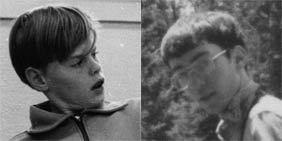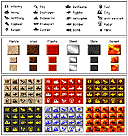
 When we were kids my friend Paul Nicholson and I invented a strategy game. We laid an old blackboard
on the floor of his garage and drew continents and oceans on it with chalk. Using the chalk and an
eraser we drew little armies and moved them around, erasing and redrawing as we went.
When we were kids my friend Paul Nicholson and I invented a strategy game. We laid an old blackboard
on the floor of his garage and drew continents and oceans on it with chalk. Using the chalk and an
eraser we drew little armies and moved them around, erasing and redrawing as we went.
Years later we both acquired Macintosh computers and came across a charming little game called Strategic Conquest. The neat thing about Conquest was that both players started with a black screen. The continents and oceans, different each time, were revealed slowly as each player built pieces and moved them about. Eventually one player would fly over one of his opponent's cities, and then the mayhem would begin. The game was as much about uncovering maps as it was about conquest.
Conquest was a great game, but we both started to see ways of improving it. In 1989, Paul suggested that we open a formal dialog and start taking notes about a new game, a game like Conquest but with many new features and pieces. We did not realize at the time that this would be the start of a nine year long obsession.
 We eventually gave our game a name: Alexander, after Alexander the Great. This exhibit is about
the evolution of that game. The heart of the exhibit is our extraordinary nine-year
dialog. We both took the project seriously and attacked it
with great vigor and creativity. Along the way we also generated a lot of
artwork: maps, diagrams, screenshots, even posters and animations.
We eventually gave our game a name: Alexander, after Alexander the Great. This exhibit is about
the evolution of that game. The heart of the exhibit is our extraordinary nine-year
dialog. We both took the project seriously and attacked it
with great vigor and creativity. Along the way we also generated a lot of
artwork: maps, diagrams, screenshots, even posters and animations.
We soon discovered that designing a strategy game is even more fun than making it. Our first
challenge was the problem of map generation. Randomly
generating continents and oceans turned out to be harder than we thought. We divided the work;
I came up with algorithms and Paul wrote the code. We finally did come up with a great
 map making program, but began to hanker for more realistic looking coastlines. Generating
coastlines, a problem we called smoothing, proved much more difficult.
map making program, but began to hanker for more realistic looking coastlines. Generating
coastlines, a problem we called smoothing, proved much more difficult.
Meanwhile, we started playing around with another problem, which we called attachment. Attachment was the process of carrying some pieces around in stacks or inside other pieces. Complications arose when we attempted to deal with the complexities of three-dimensional space. What happens, for example, when a carrier, which holds several aircraft including a helicopter (which itself holds two rangers and a spy), sails under a bridge, which holds three enemy armies moving as a single unit, while, overhead, two fighters attack a bomber (holding two bombs) while simultaneously hunting for the sub lurking underneath the carrier? Is there a simple way of directing a battle like this? Or even showing it on a map? We tried bravely to find out.
As the years slipped by, a new version of Strategic Conquest came out with some of the pieces and features Paul and I had already discussed. And Paul came across another game, Empire Deluxe, that pre-dated Strategic Conquest. Paul's Empire notes helped us analyze what kind of things other game developers were thinking of.
 One of the areas we had the most fun with was the inventing of new and improved
piece definitions. We toyed with all sorts of new pieces
including spies, engineers, rangers, radar stations, anti-aircraft emplacements, fuel dumps,
air tankers, mine-sweepers, and even sea-planes. We also spent a lot of time playing
with the idea of the city as a playing piece, even cities which make other cities.
One of the areas we had the most fun with was the inventing of new and improved
piece definitions. We toyed with all sorts of new pieces
including spies, engineers, rangers, radar stations, anti-aircraft emplacements, fuel dumps,
air tankers, mine-sweepers, and even sea-planes. We also spent a lot of time playing
with the idea of the city as a playing piece, even cities which make other cities.
Perhaps the most innovative idea we explored was a scripting language. In part this was a reaction to one of the problems with Strategic Conquest: as the number of pieces mushrooms it becomes more and more cumbersome to move them all about. We wanted to find a way of automating as much of this as possible. But this idea has more profound implications. A scripting language could add a whole new level to the game by making it a battle of programs instead of pieces. Two players could each write a series of routines and then sit back and watch their two programs duke it out. Developing a language that could express such interactive and unpredictable behavior was a fascinating challenge, one that strayed on the edges of artificial intelligence.
The final page of this exhibit provides a feature summary of the many new features we kicked around over the years. Designing a user interface for a game like this is one of the richest and most interesting user interface challenges I can imagine. Paul and I came up with a lot of interesting ideas.
Eventually our long conversation petered out and our many grand ambitions were left half done. As we entered our forties, with its distractions of marriage and mortgage, children and career, it became harder and harder to find the time to play games, let alone design them. So we never reached our original destination, but the journey was its own reward.
It would be nice if some of the creative work Paul and I did could one day see the light of day. Maybe Paul and I will take it up again when we are old men. Or maybe someone will stumble across these pages and carry some of the ideas away with them. But my main purpose here is to honor the work we did, or rather the play we did. Alexander was a great dream, and we had a great time dreaming it.